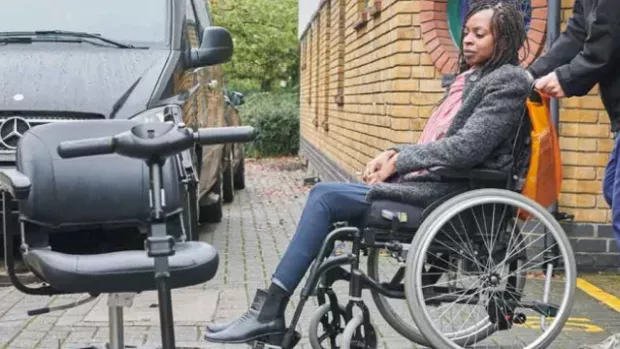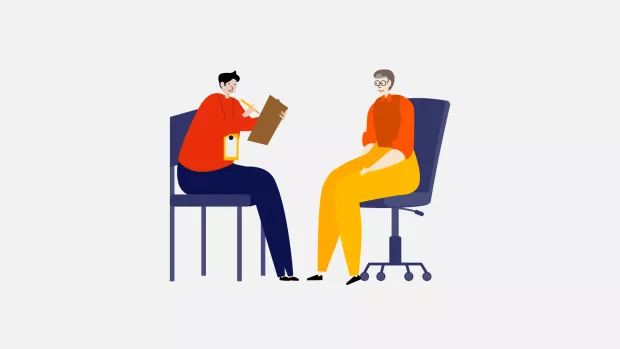
Pressure ulcers
If you spend a long time sitting or lying down in one position you could be at risk of developing pressure ulcers (also called a pressure sores or bed sores). But there are ways to avoid them - and prevention is better than cure. If you do get a pressure ulcer, it should be treated as soon as possible.
What is a pressure ulcer?
A pressure ulcer is an area of the skin or the tissue underneath the skin that’s dead or dying. It happens because blood isn’t flowing properly to the area. Left untreated, pressure ulcers can cause serious problems. But there are ways to treat and prevent them.
Who’s at risk from pressure ulcers?
You’re more at risk of developing a pressure ulcer if you:
- find it difficult to move or to change position regularly
- can’t feel the sensation of pressure building up
- use a wheelchair
- spend a lot of time in bed
- are older
- have had pressure ulcers before - scar tissue from previous ulcers is weaker and more prone to further damage
An MS relapse, which might suddenly cause reduced sensation or difficulty moving, can put you at risk of developing pressure ulcers.
What causes pressure ulcers with MS?
Pressure ulcers aren’t a direct symptom of MS. But some symptoms or the effects of living with MS might make them more likely.
The most common cause of pressure ulcers is when you rest on a small bony area without moving for a long period of time. But it can take as little as 20 minutes for pressure damage to start to develop. The pressure of your body weight on a small area of skin stops the blood flowing properly through that area.
Certain parts of the body are more at risk of pressure ulcers, including your buttocks, heels and the back of your head. These are all areas which can have a lot of pressure on them from sitting or lying down.
MS symptoms and pressure ulcers
Some MS symptoms can add to the risk of pressure building up and causing ulcers. If these are symptoms you’re experiencing, it’s worth keeping an eye out for any early signs of pressure ulcers.
Numbness
MS can sometimes cause changed sensations or a loss of feeling in certain areas. This might mean that you can't feel the sensation of pressure building up, so you don't change position to relieve the pressure.
Pain
If your MS causes you a lot of pain, you might be reluctant to change position for fear of triggering more pain - and so pressure can build up.
Bladder or bowel problems
Damp skin can be more vulnerable to damage. So it’s important to change pads or clothes regularly if they get wet.
What are the first signs of pressure damage?
Spotting the early signs of pressure damage on the skin can help avoid a pressure ulcer developing. Your skin might look different or feel different.
The skin looks different:
- red patches if you have light skin, or purplish or bluish patches if you have dark skin – especially if these patches don’t change colour when pressed
- swelling
- blisters
- shiny areas
- dry patches
- cracks, calluses, wrinkles
The skin feels different:
- hard areas
- warm areas
- swollen skin over bony points
Spotting the first signs of pressure damage if you have dark skin can be quite difficult. If you have dark skin, look out for patches that are a different colour, or that feel harder or warmer than the skin around it.
How can I avoid getting pressure ulcers?
There are a number of things you can do to prevent pressure ulcers. You might want someone to help you with some of these. A nurse can advise you and anyone who helps you.
Movement
If you spend a lot of time in a wheelchair or sitting down, try to lift your bottom off the chair every 20 minutes if you can. And change the position of your legs.
This lets the blood flow normally for a few seconds, which is all it needs. If it’s too difficult to lift your bottom, you could try a change of position. For example, leaning forwards or rolling from one side to the other.
If you’re in bed, a timed reminder on a clock or phone or a chart might be useful. It can help establish a good turning routine. You’ll need to change position at least once every two hours.
Your MS nurse or district nurse can give advice on how often you should be turning or moving.
If you find it hard or impossible to move yourself regularly, it’s important that carers can regularly move you to relieve pressure. Anyone who helps you move should be aware of certain movements which can damage the skin:
Shearing
This is when layers of skin are forced to slide over each other or over deeper tissue. It can be caused by sliding down or being pulled up a bed or chair.
Transfers
Moving from a bed to a chair, for example, can also shear the skin and cause damage, so it is important to take care to avoid knocking or dragging your body.
Friction
This can happen when clothing rubs against the skin and removes the top layer of skin. This can be caused by poor lifting and moving techniques.
Relieving pressure
There are lots of items available to help with relieving pressure. For example, special cushions, pads and mattresses. If you use a wheelchair provided by the NHS, a wheelchair therapist should assess you for any accessories you need.
An occupational therapist, physiotherapist, MS nurse or district nurse can also advise on what’s available and most suitable for you.
Find a range of pressure relieving accessories on the Living Made Easy website
Posture
Correct posture can also help relieve pressure. Sitting in a slumped position can create pressure on the large bone at the base of your spine. That can lead to shearing. To avoid slumping, make sure that your seat isn't too long or too high. Sitting with your knees higher than your hips can also create extra pressure on your sitting bones - so make sure that your seat isn't too low.
Diet
A healthy and balanced diet containing adequate amounts of protein, vitamins and minerals can help both with the prevention and healing of pressure ulcers.
Vitamin C and zinc both help wound healing. Bread, rice and pasta can help to keep the muscles healthy. Iron-rich food such as spinach and liver will help the blood carry oxygen around the body to the cells.
If you lose a lot of weight that might mean you have less padding over bony points, like your buttocks. Speak to a health care professional if you’re having unwanted weight loss. They can help find ways to get the calories you need.
Drinking plenty of fluids helps to keep the skin supple and hydrated. If you are a vegetarian or vegan, it's important to eat high-protein alternatives to meat. Cheese, yoghurt, peanut butter, custard, beans and nuts are all good sources of protein.
A dietitian or MS nurse can help you find ways to get these nutrients into your diet even if you're restricted in what you can eat.
Smoking
If you smoke, giving up is one of the most effective ways of preventing pressure ulcers. Smoking increases your risk of developing pressure ulcers.
Clothing
Avoid clothes that are too tight or have hard seams, zips or buttons that might cause pressure. Making sure your shoes fit well can also help.
Dampness
Dampness on the skin could be caused by sweat, a weeping wound or incontinence. It can make skin more vulnerable to damage. If you have problems with incontinence, the most important protection is to clean the skin and change damp clothing straight away. This avoids wetness or bacteria on the skin.
Read more about managing bladder problems
Read more about managing bowel problems
Check the skin once or twice a day
You or someone who helps you should regularly check your skin all over. You’re looking for signs of possible or actual damage, such as redness or changes in the skin.
Ideally, this should be done once a day. Or twice if possible, morning and night.
If you find a red patch and it disappears quickly after you have eased the pressure in that area, there is no cause for alarm. But if the red colour remains, this could be the first sign of an ulcer developing.
Your MS nurse can teach you, or your carer, how to do these daily skin checks.
Avoiding pressure ulcers in hospital
If you are admitted to hospital for any reason, the staff should take every measure to prevent pressure ulcers. They should make sure you change position or are repositioned regularly to prevent a pressure ulcer from developing. That’s whether in a bed, chair or wheelchair. If you’re at particular risk they should also provide any accessories you need – like special cushions or mattresses.
If you're concerned about pressure ulcers while you're in hospital, you can ask for a referral to a tissue viability nurse.
There are guidelines for health professionals to avoid and manage pressure ulcers:
- Read the pressure ulcer guidance from NICE (the National Institute for Health and Care Excellence)
- Read the pressure ulcer guidance from Health Improvement Scotland
What do I do if a pressure ulcer starts to develop?
If a pressure ulcer starts to develop, contact your district nurse or GP to get it treated promptly. Try not to put any further pressure on the affected area.
Pressure ulcers can very quickly become serious wounds, particularly if left untreated. Good management of a pressure ulcer at an early stage can prevent weeks or sometimes months of treatment.
Treating pressure ulcers
If a pressure ulcer has developed, the following steps will help you to manage it:
- Keep the area clean and free of dead tissue, to allow it to heal. Your doctor or nurse can show you how to do this.
- Try to avoid putting any further pressure on the affected area.
- Cover the ulcer with a suitable dressing. There are different dressings available so your GP or district nurse should assess the ulcer to see which one would be best.
Whoever cleans the ulcer and changes the dressing should always wash their hands. If the ulcer becomes infected, it will need to be treated with antibiotics. That could be an ointment on the skin or as an injection if the infection is deeper. Signs of infection can be:
- redness around the edge of the ulcer
- warm skin
- large amounts of greenish fluid from the ulcer
- a smell from the ulcer
- a fever (high body temperature)
Treating pressure ulcers has to consider the whole person, not just the skin affected. So it includes positioning, the use of pressure relieving equipment, moving and handling techniques, and appropriate diet and fluid intake. It can also cover a review of any medications you take, general hygiene and continence.
A district nurse or GP can help make sure the treatment is ‘holistic’ like this - looking at the whole person. They might refer you to other care professionals who can help, including physiotherapists, occupational therapists and tissue viability nurses.
Tissue viability nurses specialise in the care of people with wounds and skin problems.



